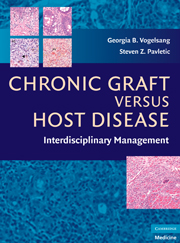Book contents
- Frontmatter
- Contents
- List of Contributors
- Preface
- PART I GENERAL PRINCIPLES
- PART II CLINICAL MANAGEMENT
- 9 Diagnosis and Staging
- 10 Chronic Graft versus Host Disease Pharmacology
- 11 Prevention of Chronic Graft versus Host Disease
- 12 Front Line Treatment of Chronic Graft versus Host Disease
- 13 Salvage Therapy in Chronic Graft versus Host Disease
- 14 Evaluating Therapeutic Response in Chronic Graft versus Host Disease
- 15 General Principles of Ancillary and Supportive Care
- PART III ORGAN SITE OR SYSTEM-SPECIFIC MANIFESTATIONS
- PART IV SPECIAL CONSIDERATIONS IN CHRONIC GVHD
- Index
- Plate section
13 - Salvage Therapy in Chronic Graft versus Host Disease
from PART II - CLINICAL MANAGEMENT
Published online by Cambridge University Press: 26 August 2009
- Frontmatter
- Contents
- List of Contributors
- Preface
- PART I GENERAL PRINCIPLES
- PART II CLINICAL MANAGEMENT
- 9 Diagnosis and Staging
- 10 Chronic Graft versus Host Disease Pharmacology
- 11 Prevention of Chronic Graft versus Host Disease
- 12 Front Line Treatment of Chronic Graft versus Host Disease
- 13 Salvage Therapy in Chronic Graft versus Host Disease
- 14 Evaluating Therapeutic Response in Chronic Graft versus Host Disease
- 15 General Principles of Ancillary and Supportive Care
- PART III ORGAN SITE OR SYSTEM-SPECIFIC MANIFESTATIONS
- PART IV SPECIAL CONSIDERATIONS IN CHRONIC GVHD
- Index
- Plate section
Summary
INTRODUCTION
Corticosteroids are the mainstay of therapy for chronic graft versus host disease (GVHD). While calcineurin inhibitors (CNI) such as cyclosporine (CSP) and tacrolimus are active in chronic GVHD therapy, they are associated with surprisingly little additive benefit. Currently, there is no standard second-line therapy for chronic GVHD and as a result, therapy for chronic GVHD often consists of prolonged administration of corticosteroids in conjunction with a CNI followed by one of several therapies with apparent, but unproven activity. In a recent randomized trial of immunosuppressive therapy for chronic GVHD, the median duration of therapy with corticosteroids and CSP was 1.6 years. Despite dual immunosuppressive therapy, only 54% of patients were successfully weaned from immunosuppressive medications at 5 years and mortality directly attributable to chronic GVHD was 17% in the combination mmunosuppressive arm. One problem in developing a rational set of therapies for chronic GVHD is the relatively immature nature of our understanding of this entity. We are only starting to understand the distinction between allogeneic and autologous reactivity that occurs after an allogeneic transplantation. Moreover, the importance of B cells, regulatory T cells (Treg), and dendritic cells has only started to come to light in the past few years. We can only hope that more effective approaches at prevention of chronic GVHD based on a better understanding of the physiology of chronic GVHD will make secondary therapy obsolete.
- Type
- Chapter
- Information
- Chronic Graft Versus Host DiseaseInterdisciplinary Management, pp. 134 - 145Publisher: Cambridge University PressPrint publication year: 2009
- 3
- Cited by

